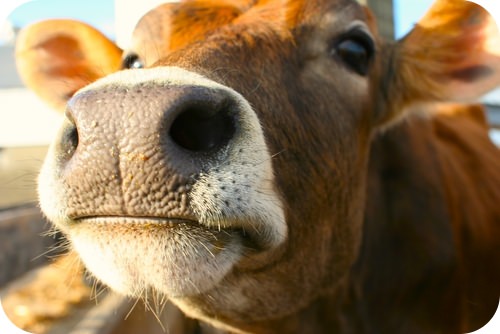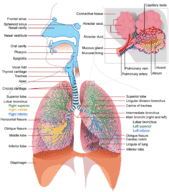4.2 呼吸系统结构
章节大纲
-
Are all noses alike?
::鼻子都一样吗?It all starts with the nose. OK, in humans maybe not the nose pictured above, but one similar to the nose below. Still, the passage of air is probably similar in cows and humans. Air comes in and then where does it go?
::这一切都从鼻子开始。 好吧,在人类身上,也许不是上面的鼻子, 而是与下面的鼻子相似的鼻子。不过,空气的通过在牛和人类身上可能相似。空气会进来,然后它会到哪里去?Structures of the Respiratory System
::呼吸系统的结构The nose and nasal cavity filter, warm, and moisten the inhaled air. The nose hairs and mucus produced by the epithelial in the nose catch airborne particles and prevent them from reaching the lungs .
::鼻腔和鼻腔过滤器、温暖和湿润吸入空气。鼻部上皮膜产生的鼻毛和粘液会抓住空气中的颗粒,防止它们进入肺部。Behind the nasal cavity, air next passes through the pharynx , a long tube that is shared with the . Both food and air pass through the pharynx. A flap of connective tissue called the epiglottis closes over the trachea when food is swallowed, to prevent choking or inhaling food. In humans the pharynx is important in vocalization. Cilia lining the nose and other parts of the upper respiratory tract move back and forth in waves, pushing foreign matter that comes in with air either toward the nostrils to be expelled or toward the pharynx. The pharynx passes the foreign matter to the stomach to eventually be eliminated by the body.
::在鼻腔后面, 空气会通过pharynx, 一种长管, 与 Pharynx 共享。 食物和空气都会通过 pharynx 。 一种称为上蛋白的结交组织, 叫做上蛋白, 在食物吞咽时, 以防窒息或吸入食物。 在人体中, 双蛋白在声响中很重要 。 鼻腔和上呼吸道其他部分的阴茎会回转, 随气而流入鼻腔的外国物质会被排出, 或者是被排出去鼻腔, 或者是被排入Pharynx 。 pharynx 将异物传到腹部, 最终被身体消灭 。The larynx , also called the voicebox, is found just below the point at which the pharynx splits into the trachea and the esophagus , shown in Figure . The voice is generated in the larynx. Air from the lungs is needed for the vocal folds to produce speech.
::喉咙也称为语音箱,在Pharynx分裂到气管和食道的点下方,如图所示。声音在喉咙中产生。需要肺部空气才能产生语音。The trachea, or wind pipe, is a long tube that leads down to the chest where it divides into the right and left bronchi in the lungs. The bronchi branch out into smaller bronchioles , which are the first airway passages that do not contain cartilage . The bronchial tubes lead directly into the lungs where they divide into many smaller tubes that connect to tiny sacs called alveoli , which are the multi-lobed sacs in which most of the gas exchange occurs. The average adult's lungs contain about 600 million of these spongy, air-filled sacs that are surrounded by capillaries.
::气管,即风管,是一个长长的管子,通向胸口,分到右侧和肺部的左支郎。支气管分到较小的支气管,这些支气管是第一个没有软骨的气道通道。支气管直接通向肺部,分成许多较小的管子,连接到称为alveoli的小型囊囊囊,这些囊囊囊囊是多层的囊囊囊,大部分气体交换都发生在这些囊囊中。成年人的平均肺部含有大约6亿个被卷心菜包围的气垫和充气的囊囊。The structures of the respiratory system include the nasal cavity, the pharynx, and the larynx, which together are the upper respiratory tract. The trachea, bronchi, bronchioles, and alveoli are part of up the lower respiratory tract.
::呼吸系统的结构包括鼻腔、巴林克斯和喉,它们合在一起是上呼吸道,气管、支气管、支气管和单叶是下呼吸道的一部分。Summary
::摘要-
Oxygen is inhaled and first passes through the nasal cavity before entering the pharynx. The pharynx splits off into the larynx and the trachea. Oxygen then goes from the trachea into the bronchi, bronchioles, and eventually the alveoli within the lungs.
::氧气被吸入,先通过鼻腔,然后进入阴道。 阴道裂开进入喉和气管。 然后,氧气从气管进入支气管、支气管,最终进入肺内。
Review
::回顾-
What are the roles of nose hairs and mucus?
::鼻毛和黏液的作用是什么? -
What is the role of the epiglottis?
::上衣人的作用是什么? -
What are the first airway passages that do not contain cartilage?
::第一批没有软体软化的气道通道是什么?
-
Oxygen is inhaled and first passes through the nasal cavity before entering the pharynx. The pharynx splits off into the larynx and the trachea. Oxygen then goes from the trachea into the bronchi, bronchioles, and eventually the alveoli within the lungs.


